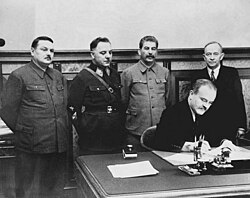Military occupations by the Soviet Union
During World War II, the Soviet Union occupied and annexed several countries effectively handed over by Nazi Germany in the secret Molotov–Ribbentrop Pact of 1939.[5][6] Apart from the Molotov–Ribbentrop Pact and post-war division of Germany, the USSR also occupied and annexed Carpathian Ruthenia from Czechoslovakia in 1945 (became part of Ukrainian SSR).Estonia, Latvia, and Lithuania had been independent nations since 1918, when all three countries were occupied by the Red Army in June 1940 and formally annexed into the USSR in August 1940.[15] Given a free hand by Nazi Germany via the German–Soviet Nonaggression Pact and its secret additional protocol of August 1939,[16] the Soviet Union pressured the three countries to accept its military bases in September 1939.In the case of refusal, the USSR effected an air and naval blockade and threatened to attack immediately with hundreds of thousands of troops massed upon the border.The Soviet military forces overtook the political systems of these countries in June 1940 and installed puppet regimes after rigged elections in July 1940.The punitive actions decreased rapidly after Joseph Stalin's death in 1953; from 1956 to 1958, a large part of the deportees and political prisoners were allowed to return.[17] Furthermore, trying to enforce the ideals of Communism, the authorities deliberately dismantled the existing social and economic structures, and imposed new "ideologically pure" hierarchies.Until 1991, the status of the three countries resembled the classical occupation in important ways: external control by an internationally unsanctioned force and a conflict of interest between the foreign power and the inhabitants.[19] Although the Soviet Union condemned the Molotov–Ribbentrop Pact[20][21]—the immediate forerunner to the occupation—it is currently the policy of the USSR's legal successor Russian Federation to deny that the events constituted occupation or were illegal under applicable (international) laws.When the hostilities resumed in 1941, Finnish forces retook the lost areas and then advanced further up to the Svir River and Lake Onega before the end of the year.German lead European Axis countries and Finland invaded the USSR, thereby terminating the German-Soviet non-aggression treaty.The purpose of the invasion (codenamed Operation Countenance) was to secure Iranian oil fields and ensure supply lines (see Persian Corridor) for the Soviets fighting against European Axis countries on the Eastern Front.Operations continued until early April 1945, when the last German forces and their remaining loyal Hungarian troops were routed out of the country.On 4 November 1956, a large joint military force of the Warsaw Pact led by Moscow, entered Budapest to crush the armed resistance, killing thousands of civilians in the process.Garrison detachments with Zveno officers at the head overthrew the government on the eve of 9 September, after taking strategic keypoints in Sofia and arresting the ministers.On 26 November this committee, led by Ivan Turyanytsia (a Rusyn who deserted from the Czechoslovak army) proclaimed the will of Ukrainian people to separate from Czechoslovakia and join the Soviet Ukraine.After two months of conflicts and negotiations the Czechoslovak government delegation departed from Khust on 1 February 1945, leaving the Carpathian Ukraine under Soviet control.In 1944–1946, Soviet troops occupied northern Norway and the Danish island of Bornholm, strategically situated at the Baltic sea entrance.Soviet forces departed in 1948, and a few years later, in an attempt to unite Korea under Communist rule, the Korean War broke out.On 4 November 1956, a large joint military force of the Warsaw Pact, led by Moscow, entered Budapest to crush the armed resistance.[54] Leonid Brezhnev, General Secretary of the Communist Party of the Soviet Union, reacted to these reforms by announcing the Brezhnev Doctrine, and on 21 August 1968, about 750,000 Warsaw Pact troops, mostly from the Soviet Union, Poland, Bulgaria and Hungary, with tanks and machine guns occupied Czechoslovakia, deported thousands of people and rapidly derailed all reforms.Most large cities were individually invaded and overtaken; however, the invasion's primary attention focused on Prague, particularly the state organs, Czech television and radio.In 1987, the Soviet leader Mikhail Gorbachev acknowledged that his liberalizing policies of glasnost and perestroika owed a great deal to Dubček's socialism with a human face.The last occupation troops left the country on 27 June 1991[55] During a visit to Prague in 2007, Vladimir Putin said that he felt the moral responsibility for the 1968 events and that Russia condemned them.With Amin's death at the palace, Babrak Karmal, exiled leader of the Parcham faction of the PDPA was installed by the Soviets as Afghanistan's new head of government.





World War IISoviet UnionannexedNazi GermanyMolotov–Ribbentrop Pactthe eastern regionsPolandthree different SSRsLatviaLatvian SSREstoniaEstonian SSRLithuaniaLithuanian SSRKarelo-Finnish SSRRomaniaMoldavian SSRUkrainian SSRCarpathian RutheniaCzechoslovakiamilitary occupationsCold WarAllied victorySoviet invasion of PolandTerritories of Poland annexed by the Soviet UnionOccupation of Poland (1939–1945)Northern Group of ForcesProvisional Polish Revolutionary CommitteeGalician Soviet Socialist RepublicTimelines of World War IIPreludein Asiain EuropeAftermath1945 onwardsCausesDiplomacyDeclarations of warBattlesOperationsBattle of Europe air operationsEastern FrontManhattan ProjectUnited Kingdom home frontSurrender of the Axis armiesBiałystokPrzemyślRegained Territoriescommunist regime in PolandPolish government-in-exileOccupation of the Baltic statesoccupiedRed ArmyGerman–Soviet Nonaggression Pactrigged elections in July 1940CampaignsCountriesEquipmentTimelineOutlineHistoriographyBibliographyGermanBaltic Offensivecollectivisation of agriculturemass deportationresistance movementforest brothersJoseph Stalinunlawfully draftedcrimes against humanitynew resistance movementSoviet republicssui generisRussian FederationFinnish Democratic RepublicWinter WarKarelian questionKarelian IsthmusGulf of FinlandTerijokiPetsamo municipalityBarents SeaMoscow Peace TreatyKareliaRybachy PeninsulaViipuriSvir RiverLake OnegaSoviet offensive of 1944Battle of IlomantsiMoscow ArmisticePetsamo–Kirkenes OffensiveSoviet occupation of Bessarabia and Northern BukovinaBessarabiaunion of 1918BukovinaAdolf HitlerGerman attack on USSRHistory of the Soviet Union (1927–1953)Eastern BlocOperation BarbarossaSoviet SatellitePeople's Republic of PolandPeople's Republic of HungaryCzechoslovak Socialist RepublicRomanian People's RepublicPeople's Republic of BulgariaPeople's Republic of AlbaniaEast GermanyAnglo-Soviet invasion of IranIran crisis of 1946British and Commonwealth forcesPersian CorridorAzerbaijan People's GovernmentIranian AzerbaijanCoat of armsBudapestMilitary administrationSemyon TimoshenkoKliment VoroshilovSecond World WarFall of BudapestParis Peace TreatiesGerman occupation of HungarySecond Hungarian Republic